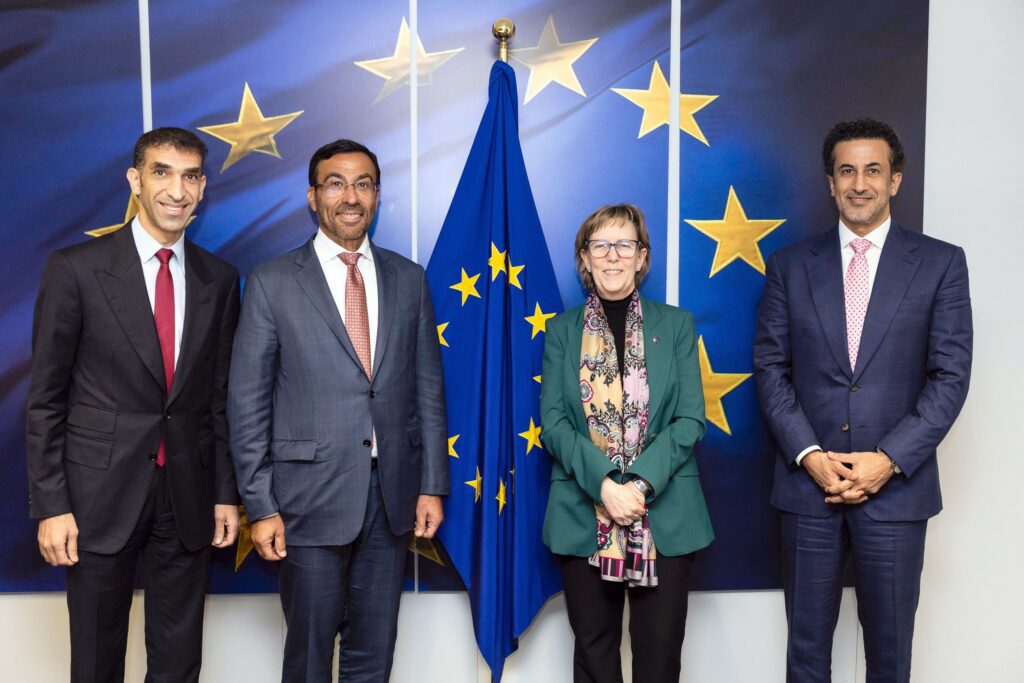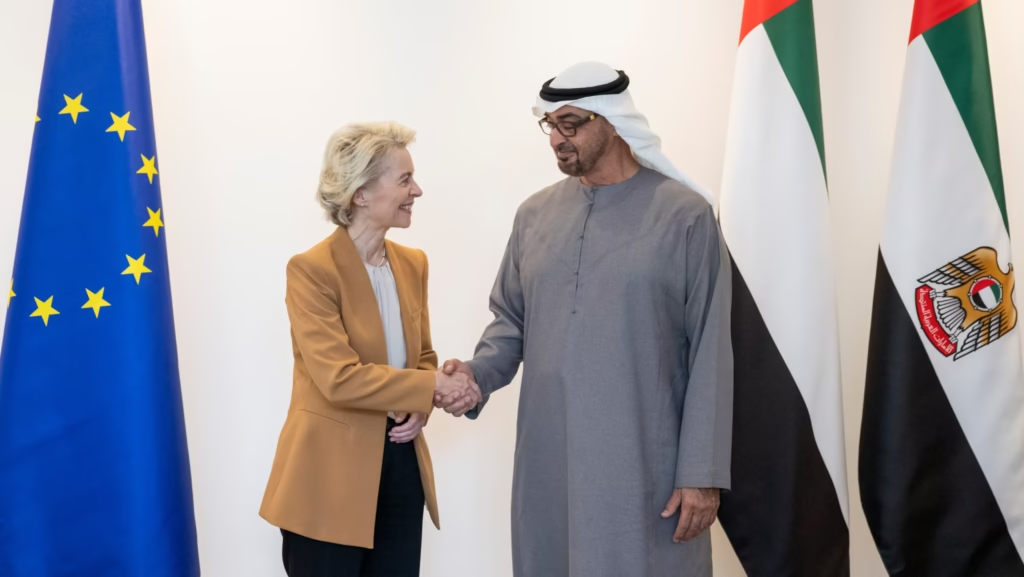The EU-UAE Free Trade Agreement represents a major milestone in international trade and economic cooperation. It marks the beginning of a new chapter in relations between the European Union and the United Arab Emirates, one built on shared interests, mutual respect, and a commitment to growth. For decades, the EU and the UAE have maintained strong economic ties, with trade, investment, and collaboration growing steadily. Now, with the launch of negotiations for a Comprehensive Economic Partnership Agreement, the potential for a deeper, more strategic partnership is clearer than ever.
This agreement aims to strengthen bilateral relations by removing trade barriers, improving market access, and fostering investment in priority sectors. The CEPA is not only about trade; it is a forward-looking initiative focused on innovation, sustainability, and regional cooperation. By creating an economic framework that encourages collaboration in areas such as renewable energy, digital technology, logistics, and infrastructure, the EU and UAE are setting the stage for a partnership that could reshape economic engagement in the Gulf region and beyond.
Strengthening Bilateral Ties
The European Union is the UAE’s second-largest trading partner globally, and non-oil trade between the two regions has been steadily increasing. With growing investments in sectors such as technology, energy, and logistics, there is significant potential to deepen this economic relationship. The EU-UAE Free Trade Agreement provides a structured mechanism to further this collaboration.

The agreement promises to remove trade barriers, including tariffs and administrative hurdles, making it easier for businesses from both regions to access new markets. It also seeks to harmonize regulations where possible, fostering smoother business operations and reducing costs. Beyond trade in goods, the agreement aims to expand services, investment opportunities, and intellectual property protections, creating an environment that encourages long-term economic cooperation.
By focusing on both traditional trade sectors and emerging industries, the CEPA reflects the modern global economy’s evolving needs. This approach signals a shift from standard trade agreements to comprehensive partnerships that integrate multiple dimensions of economic activity, from renewable energy projects to advanced digital technologies.

Key Areas of Cooperation
Renewable Energy and Green Hydrogen
One of the most promising areas of collaboration under the EU-UAE Free Trade Agreement is renewable energy. The UAE has been investing heavily in renewable energy projects, from solar parks to green hydrogen initiatives. These efforts align with the EU’s ambitious climate and energy transition goals, making energy cooperation a natural priority.
Green hydrogen, in particular, represents a critical opportunity. By producing hydrogen through renewable energy sources, the UAE can supply clean energy to the EU, supporting decarbonization efforts. This cooperation will not only facilitate technological exchange but also encourage joint investments in infrastructure, production facilities, and distribution networks. The EU, with its advanced research and industrial capabilities, and the UAE, with its strategic location and energy resources, form a complementary partnership that could accelerate the global transition to cleaner energy.
Moreover, collaboration in renewable energy has broader implications for sustainability and economic diversification. It helps the UAE reduce its dependence on oil, supports job creation in high-tech industries, and positions the region as a hub for green technology and innovation. For the EU, access to renewable energy resources and investment opportunities strengthens energy security and contributes to climate objectives.

Digital Economy and Artificial Intelligence
The digital economy is another cornerstone of the EU-UAE partnership. Both regions recognize that technology and innovation drive growth and competitiveness. Under the agreement, collaboration in artificial intelligence, cybersecurity, and digital services is expected to grow significantly.
By fostering innovation and technological exchange, the EU-UAE Free Trade Agreement encourages the development of advanced digital infrastructure. This includes smart city initiatives, cloud computing, and AI-driven solutions that enhance public services, business efficiency, and economic productivity. For companies operating in both regions, the agreement provides a framework for cooperation on data standards, digital regulations, and research partnerships.
AI applications can extend to healthcare, finance, transportation, and logistics, creating a wide array of business and societal benefits. For example, AI-driven logistics solutions can optimize supply chains, while AI in healthcare can improve diagnostics and patient care. By combining European expertise in AI research with the UAE’s investment capacity and strategic positioning, both regions stand to gain significantly from this collaboration.
Logistics and Infrastructure Development
The UAE’s geographic position at the crossroads of Europe, Asia, and Africa makes it a global logistics hub. The EU, on the other hand, has advanced infrastructure, extensive trade networks, and technological know-how. Together, they can create a seamless trade and transportation system that enhances efficiency and reduces costs.
The EU-UAE Free Trade Agreement aims to streamline customs procedures, improve port and airport connectivity, and promote joint infrastructure projects. By simplifying regulatory frameworks and harmonizing logistics standards, goods and services can move more efficiently between the two regions. This cooperation is crucial for industries like manufacturing, pharmaceuticals, and e-commerce, where timely delivery and supply chain reliability are essential.
Infrastructure development also extends to joint investments in transport, energy, and digital networks. These projects not only facilitate trade but also generate employment opportunities, promote regional development, and encourage technological innovation. Enhanced connectivity strengthens the UAE’s role as a gateway to the Middle East and Africa, while giving EU businesses easier access to new markets.
Trade in Services and Investment Opportunities
The EU-UAE Free Trade Agreement is not limited to goods; it also focuses on services and investment. Financial services, professional consulting, tourism, education, and healthcare are among the sectors poised for expansion under the agreement. By improving market access and reducing restrictions, businesses can explore new opportunities with confidence.
Investment provisions in the CEPA protect investors and encourage long-term partnerships. European companies benefit from a stable regulatory environment in the UAE, while Emirati firms gain access to the EU’s large consumer market and advanced industrial base. This mutual protection fosters innovation, encourages entrepreneurial activity, and promotes sustainable economic growth.
Additionally, the agreement creates a framework for public-private partnerships and joint ventures. Such collaborations can accelerate knowledge transfer, drive technology adoption, and facilitate best practice sharing between the two regions. Over time, this can lead to the creation of globally competitive industries and increase overall economic resilience.
Strategic Implications
The EU-UAE Free Trade Agreement is more than an economic pact; it has significant geopolitical and strategic implications. For the EU, the agreement strengthens its presence in the Gulf region, providing a model for future engagement with other GCC countries. For the UAE, it reinforces its position as a global business hub and promotes economic diversification beyond oil.
By creating a robust framework for bilateral cooperation, the agreement also enhances regional stability. Economic interdependence often leads to closer political dialogue and stronger diplomatic ties. The CEPA demonstrates how trade and investment can act as instruments of broader international cooperation, fostering trust and mutual understanding between nations.
Moreover, the agreement highlights the importance of aligning economic growth with sustainability and innovation. It positions both regions as leaders in addressing global challenges, from climate change to digital transformation, while creating tangible benefits for businesses and citizens alike.

Challenges and Considerations
While the EU-UAE Free Trade Agreement offers significant opportunities, challenges remain. Differences in regulatory standards, labor laws, and intellectual property frameworks require careful negotiation. Both sides must ensure that protections are balanced and that businesses are not burdened by unnecessary compliance costs.
Cultural and legal differences also play a role. Successful collaboration depends on mutual understanding and respect for local practices and regulations. This includes considerations for data privacy, environmental standards, and corporate governance.
Despite these challenges, the commitment of both parties to dialogue and cooperation is strong. Negotiators have emphasized transparency, flexibility, and problem-solving as guiding principles. The willingness to find common ground demonstrates that the EU and UAE are prepared to overcome obstacles to realize the full potential of the agreement.
Looking Ahead
As negotiations progress, the EU-UAE Free Trade Agreement is shaping up to be a landmark initiative. Its success will not only impact trade and investment but also serve as a blueprint for future international partnerships. By emphasizing mutual benefits, sustainability, and innovation, the agreement reflects the evolving nature of global trade relations.
The CEPA sets a precedent for how developed and emerging economies can collaborate on multiple fronts, from energy and technology to services and infrastructure. Its comprehensive approach ensures that both regions are well-positioned to navigate the challenges of a rapidly changing global economy, including shifts in supply chains, technological advancements, and environmental concerns.
Looking ahead, the agreement could pave the way for broader regional integration. It may inspire similar bilateral or multilateral trade deals, encouraging other countries in the Gulf and Europe to explore mutually beneficial partnerships. In this way, the EU-UAE Free Trade Agreement has the potential to influence not only bilateral relations but also the broader dynamics of global trade and cooperation.
Conclusion
The EU-UAE Free Trade Agreement heralds a new era of economic partnership, demonstrating the power of strategic collaboration. By focusing on shared goals such as renewable energy, digital innovation, and infrastructure development, the agreement creates opportunities for sustainable growth and prosperity.
For businesses, investors, and governments, the CEPA represents a stable and forward-looking framework for engagement. It encourages innovation, supports job creation, and strengthens regional and global trade networks. By fostering trust and cooperation between the EU and UAE, the agreement sets the stage for a mutually beneficial relationship that will endure for decades.
Ultimately, this partnership exemplifies the importance of vision, collaboration, and commitment in building a stronger, more resilient global economy. The EU-UAE Free Trade Agreement is not just about trade; it is about creating a shared future, grounded in economic opportunity, technological advancement, and sustainable development. As both regions continue to work together, the possibilities for growth, innovation, and progress are limitless.
Do follow UAE Stories on Instagram
Read Next – Digital Remittance Apps in UAE and Saudi Arabia Gain Momentum














